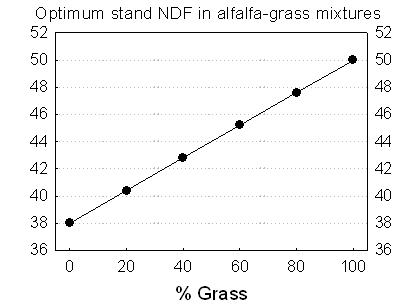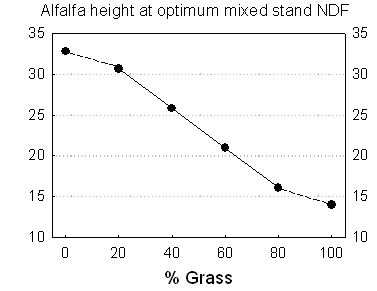Introduction (Grass, Alfalfa-grass, Alfalfa)
Grass
It is particularly difficult to assess standing quality of pure grass without actually analyzing samples. Grass morphology changes are not obvious until heading, once grass has headed it is too late. Often a calendar date works as well as any morphological indicators for spring harvest. In our region this date varies from May 15 to May 30.
Alfalfa-grass
A study was undertaken recently to develop a system for estimating standing NDF of alfalfa-grass mixtures (Parsons, 2005). Figure 3 shows the estimated optimum NDF of standing forage at harvest for mixtures and pure alfalfa or pure grass. These goals assume a 10-15% decline in forage quality due to harvest, storage and feedout.

Figure 3. Optimum NDF of standing forage, assuming pure stand optimums of 38% for pure alfalfa and 50% for pure grass.
Figure 4 is the estimated alfalfa height needed to harvest at optimum stand NDF. For a more accurate estimate of standing NDF in mixtures, we have equations based on alfalfa height, sampling date, and an estimate of the grass:legume ratio (10-30%, 30-50%, etc.). Prediction equations for NDF of mixed alfalfa-grass stands were developed based on sampling and separating mixtures from fields across NYS in 2004 and 2005. Table 1 is based on a prediction equation using alfalfa height and percent grass.

Figure 4. This provides a gross estimate of alfalfa height (height of tallest stem) at harvest, for pure stands and mixtures. For mixtures, use alfalfa height in the mixture. For 100% grass, use estimated height in a pure stand of alfalfa nearby.
Table 1. Estimated stand NDF of a mixed alfalfa-grass stand based on alfalfa height and the percent grass in the stand. Target NDF for each mixture is highlighted.

Alfalfa
Text
Top
|